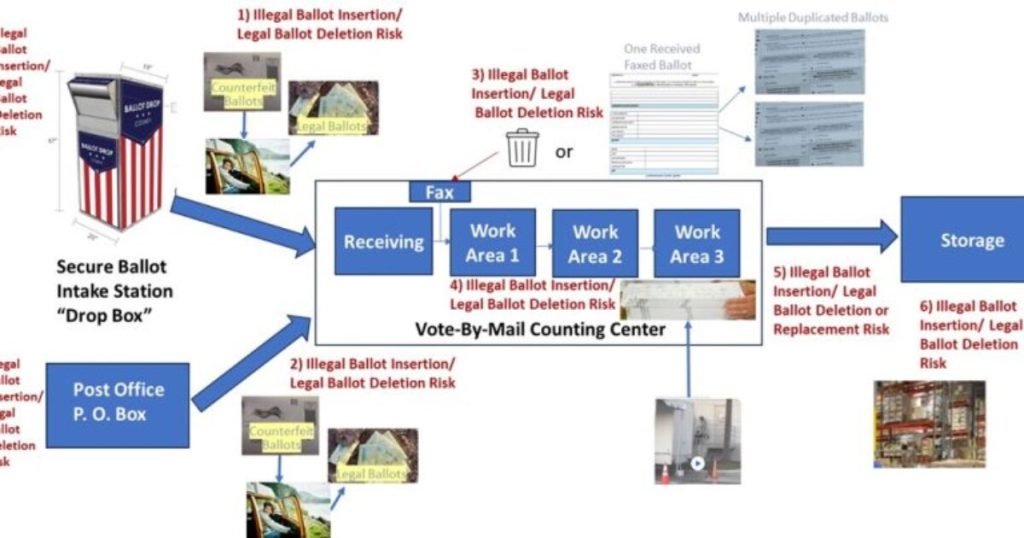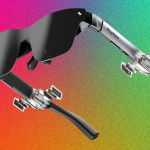Guest post by Joe Hoft at JoeHoft.com – republished with permission.
This is part two of a series on how to ensure a fair election.
The way to win the 2024 Election includes guarding, validating and reconciling all ballots counted in the election (Part II).
Last week, we revealed how to win the 2024 election. We all win if the election results are fair, legitimate and certifiable.
After the 2020 Election many Americans believed that the results were stolen because they never should have been certified and they never want to see that happen again. Ballots were inserted into the election in drop boxes, through the mail, and on election day. But many people believe that large numbers of these ballots were not legitimate.
We compared our elections to Venezuela’s recent election and proposed solutions for ensuring the 2024 Election in the US is fair and transparent.
The AP reported that the Venezuela Opposition Party, in the recent election, prevented their election from being stolen by obtaining the legitimate vote tally sheets processed during their election before the communist Maduro regime could pull off another election steal. Maduro the communist stole the election anyway but the truth is out there.
A solution to ensuring a fair and transparent election is to do similar activities in the 2024 election at the precinct level. This was all outlined in our first post on this subject:
HOW TO WIN IN 2024 — Guard, Validate and Reconcile All Ballots Counted in the Election
As noted in our first article, there are numerous election integrity groups formed since 2020 that are working to ensure the 2024 election is fair and legitimate.
One of these groups is FATE 2024 which was formed by a group of experts and hardworking Americans in an effort to help ensure a secure 2024 election.
The experts at FATE 2024 concluded that whether or not election machines were going to be used in the 2024 Election and no matter how many votes are counted, the paper ballots must agree with the final results. To ensure this, these experts designed a process that expanded on what the opposition party in Venezuela did recently.
Voting machines are used in both Venezuela and the US. However, public observation, recording, and reporting needed to secure elections are more complex and robust in the US because the US has vote-by-mail and early voting. Venezuela has one-day in-person voting only. According to Pew Research, in 2020, most countries will only support in-person voting.
Below is a chart showing the actions that are necessary to ensure trust and accuracy in US elections. Reconciliations should be performed daily at precincts and vote-by-mail counting centers and verified through observation, record collection, and independent validation. Corrections should be addressed before certification.
Today we provide a template for reconciling ballot related activities at vote-by-mail counting centers.
There are several points in vote-by-mail transport and processing where there is a risk of illegal ballot insertion, legal ballot deletion, or legal ballots being replaced by illegal ballots. These points include:
During the transport between drop boxes and the vote-by-mail counting center
During the transport between the Election Supervisor’s P. O. Box and the vote-by-mail counting center (typically done by election workers, not USPS workers)
In the UOCAVA (military) facsimile receipt area
In the vote-by-mail counting center within and between work areas
During the transport of ballots to storage
Within the storage area
See the following diagram that depicts these areas of concern:
Chain of Custody
If physical evidence used in a criminal trial or obtained in corporate audits has broken chain of custody or is left unattended without physical security it cannot be used in a court of law because there is no way of knowing if the evidence has been tampered with, planted, or deleted.
The same principle applies to containers of ballots. If the chain of custody of a ballot container is broken, the ballots cannot be counted because there is no way to know if any ballots in the container have been deleted, replaced, or inserted. If ballots may have been compromised, voters should be given the opportunity to re-cast their ballot.
The possession of ballots must be fully documented and witnessed in every step of the process, ballots must be kept physically secure, and procedural audits must be done to ensure the process is properly implemented.
In most counties across the US election workers pick up vote-by-mail ballots from the Post Office. Ask your county election office for a copy of their Post Office chain of custody form. If they don’t use a form or have a form that is not as robust as the sample form below – insist that this is addressed before November to protect your vote.
Here is a sample Post Office chain of custody form:
Post Office Chain of Custody Form by Joe Ho on Scribd
Reconciliations
Reconciliations are performed to ascertain results are accurate. This technique compares two sets of records to check that the figures are correct and in agreement. Reconciliation of vote-by-mail ballots must be successfully completed to prove that all legal ballots and only legal ballots are counted.
It is critical for the reconciliation to be completed before certification – ideally, it should be performed on a daily basis so that problems can be addressed before election outcomes are compromised.
Related reconciliations and validations include:
Validation that the number of vote-by-mail ballots returned by voters does not exceed the number of ballots requested by and mailed to voters.
If pre-paid ballot postage is paid for by the election office, validation that the number of voted ballots transported between the Post Office and the vote counting center reconcile with the number of returned ballots the Post Office has billed for.
Validation that the quantities of UOCAVA (military) ballots processed equals quantities of ballots received per the UOCAVA facsimile log.
Validation that the ballot chain of custody forms show that ballots were transferred on a timely basis without overnight delays, seals were intact, and the ballot quantities counted at sending and receiving locations match.
Validation that the number of voted and tabulated ballots transferred to storage equals the number of ballots reported as counted.
Candidate and public observation, recording, reporting, and reconciliation procedures
Observation
The following are some observation activities to be performed in the vote-by-mail process. This may change based on state law or local policy and it should be negotiated in advance of the election:
Initial facility inspection – Before receiving vote-by-mail ballots, the Canvassing Board and candidates or their delegates should verify that no completed or blank vote-by-mail ballots are present and that adequate physical security is in place.
Receiving docks – Docks should be under observance 24×7 after the vote counting center inspection is first performed. The docks may be videotaped by the public if allowed by state law. If public videotaping from the building exterior is not allowed by law or policy, then other means of preventing illegitimate ballots from being unloading in the receiving doc area should be implemented. Perhaps the vote counting center would agree to streaming video of their receiving docks and enable public?
Completed ballot chain of custody forms – Requesting that transport and work area chain of custody forms be displayed on a public website so that chain of custody objections can be made by candidates or their designees before ballots are co-mingled or counted is recommended.
If an inbound mail sorter is used, a report is generated after each delivery is processed noting the number of ballots processed in the delivery. The mail sorter report should also be viewable to candidates or their designees.
As the ballots are moved between work areas within the vote counting center and off to storage, the work area chain of custody forms should be updated, scanned, and provided on a timely basis to candidates or their designees.
After vote-by-mail ballot counting is completed, candidates or their delegates should tour the vote-counting center to verify no unprocessed ballots are present and that the processed ballots are sealed and securely stored.
Recording
As laws and local policies permit, vote-by-mail observers should make a written record and take a picture or video of:
License plates of delivery vehicles
Ballot containers being unloaded from transport vehicles at the dock
Empty delivery vehicles after ballots are removed
Public monitors displaying ballot transport or work area chain of custody forms or video of operations
Received ballot containers during public viewing
Public monitors displaying ballot duplication activity if allowed by law
Public monitors displaying mail sorter or tabulator reports
Public monitors displaying vote-by-mail reconciliation forms, duplication logs, and adjudication logs
Any area or activity in processing of votes that does not expose a signature or a voted ballot.
Reporting
A well-defined method is needed to enable observers to report issues and data collected to election officials, candidates/political parties, election integrity groups, or law enforcement, if required.
Election records should be made available to candidates and the public prior to certification. These records are necessary to perform reconciliations.
Completed and blank ballot reconciliation forms for in-person voting and vote-by-mail
Completed chain of custody forms
UOCAVA (military) facsimile logs
Post Office billing records
Daily ballot tracking service provider reports
Absentee Totals report (daily)
Undervote/Overvote report (daily)
Purchasing and receiving records of election materials, including ballots, envelopes, seals, and mailing services
Vote-by-mail tabulator tapes
Ballot on Demand print logs
Wireless carrier billing records for wireless modems used in tabulators or other election systems
Mail sorter logs
Images of ballot envelopes collected by mail sorters with signatures hidden
Daily pictures of clock totals at the beginning and end of each workday if clocks are used to stamp incoming vote-by-mail ballots
The attachment below provides sample forms that can be used at counting centers to collect and report on activities at these locations.
Vote-By-Mail Counting Center Observation v2 by Joe Ho on Scribd
Training related to the above templates will be provided by FATE 2024 in video at a future date. In addition, a robust Model Election Security plan with more details on the reconciliation process and election security is located here.
If Americans can protect the ballots and the processes surrounding ballots that are counted in the 2024 Election, an accurate result will ensue.
The post How to Win in 2024 (PART II) – Guard, Validate and Reconcile All Ballots Counted at Vote-By-Mail Counting Centers appeared first on The Gateway Pundit.







